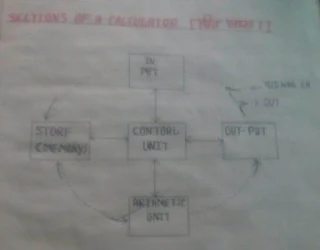Calculator Processing Unit:
A Calculator Processing Unit (CPU) is the central component of a calculator or any computing device. It is often referred to as the "brain" of the calculator because it performs most of the calculations and executes instructions. The CPU interprets and carries out the basic arithmetic, logical, control, and input/output (I/O) operations specified by the calculator's software.
Key Functions of a Calculator CPU:
1. Arithmetic Operations: The CPU performs basic arithmetic operations, such as addition, subtraction, multiplication, and division. It processes numerical data and performs calculations based on the instructions provided.
2. Logical Operations: The CPU executes logical operations, including comparisons (equal to, greater than, less than) and Boolean operations (AND, OR, NOT). These operations are essential for decision-making processes within the calculator's algorithms.
3. Control Operations: The CPU manages the flow of instructions and data within the calculator. It fetches instructions from memory, decodes them, executes the operations, and stores the results back in memory or displays them on the calculator's screen.
History of Computer
4. Memory Access: The CPU accesses data and instructions stored in the calculator's memory. It reads data from memory for processing and writes the results back to memory after calculations.
5. Input/Output Operations: The CPU interacts with input devices (such as keyboard or touchpad) to receive user input and output devices (such as display screen or printer) to present results to the user. It processes input data and controls the output display.
6. Clock and Timing: The CPU operates based on a clock signal, which synchronizes the processing tasks. Clock cycles regulate the flow of instructions and data, ensuring that calculations are performed in the correct sequence.
What is Smartphone?
Components of a Calculator CPU:
1. ALU (Arithmetic Logic Unit): The ALU performs arithmetic and logical operations, manipulating numerical data and making decisions based on logical conditions.
2. CU (Control Unit): The Control Unit manages the flow of instructions, interprets program commands, and directs data movement between the CPU, memory, and I/O devices.
3. Registers: CPU registers are small, fast storage locations used for temporary data storage and manipulation. They store data, addresses, and intermediate results during calculations.
4. Clock and Timing Circuitry: The clock generates regular pulses that synchronize the activities of various CPU components, ensuring that instructions are executed in the correct order.
Calculators, ranging from simple handheld devices to advanced scientific or graphing calculators, have CPUs tailored to their specific functionalities. The CPU's efficiency and processing speed significantly influence a calculator's performance, enabling users to perform various mathematical and scientific calculations quickly and accurately.
Output device
